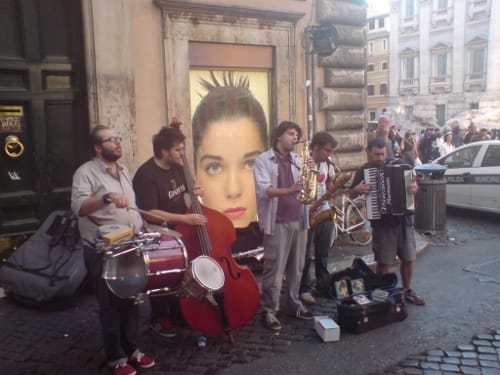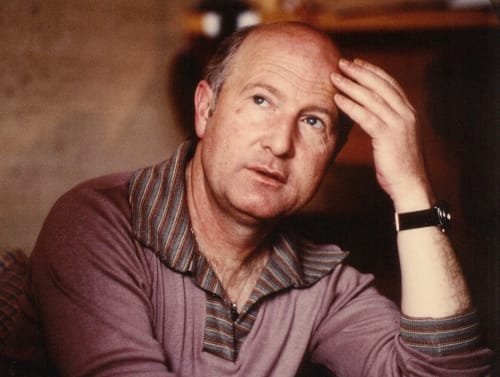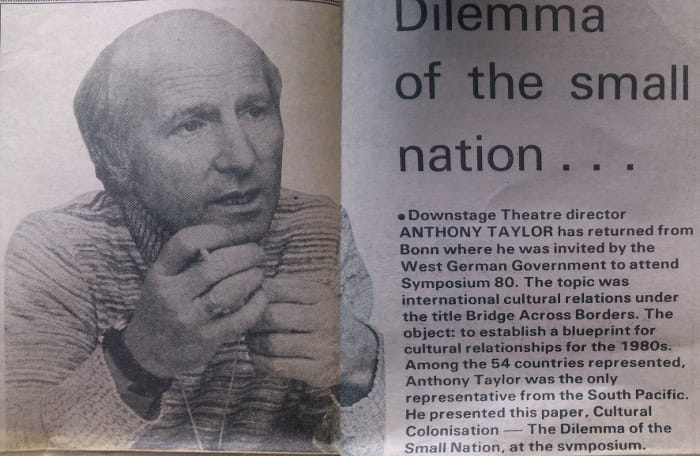Alejandro Iglesias Rossi: the path with heart

the following is a transcript of Alejandro Iglesias Rossi’s “The Path with Heart” broadcast on Radio New Zealand:
The path with heart
If you are you because I am me
and
I am me because you are you
then
neither you are you
nor
I am me
but
if you are you because you are you
and
I am me because I am me
then
you are you
and
I am me.
This text by an 18th century mystic of the biblical tradition, elliptaically brings us to the heart of our subject.
Spiritually – we are at the crossroads of the need to find our personal identity as creators and, our cultural identity as members of a community that encompasses us. In this context the term
‘creator’ applies not only to the so-called ‘artist’ but to the teacher, the builder, the office worker, the farmer, the scientist… The term creator doesn’t address what you are working WITH, but HOW you are working.
‘The power we seek is the power with which we seek.’
The challenge is how to be oneself, discovering one’s “uniqueness” in all its potency.
This process of discovery not only changes us, but also influences and transforms the very culture we’re born into. Those willing to take this path
must digest and internalize all their cultural heritage for their talents to reappear with a special power. This unique quality will broaden the borders of knowledge, as we explore still unknown lands – as real co-creators.
Bagualas
You are listening to a Baguala, a vocal style from North-western Argentina…a sacred earthly howl…
Thunder sfx
Ascension
In Ascension Las Tierras Nuevas – Ascension – The New Earths, the work we are listening to, the challenge was to draw on the two traditions that have influenced me the most spiritually – the biblical and indigenous traditions of my country.
“Ascensión” was composed using samplings of sacred european music from the 11th to the 16th centuries and recordings of indigenous orchestras and singers from South America.
You can also hear the sounds of the ethnic instruments from Kollasuyu –
The name of the the ancient southern extent of the Incan empire, now North-western Argentina. Those instruments are:
sikus (panflute), erke (horn), moxeño (traverse flute) and quena (straight flute) …and are played by myself.
According to Judeo-christianity the whole architecture of the Bible points towards the arrival of the new earth and the new sky – the day on which our exile will come to an end and all the holy promises will become true.
In the bibilical mystical tradition, as beings who inhabitat this strange place and time, we can help to construct that moment, we can make it come sooner or delay its arrival depending on whether or not we engage our hearts to love. As St Paul states – – “bearing all things, believing all things, enduring all things”.
Moreover, this tradition says, we can catch glimpses of what that time will be like, in whatever human work has been done with true sacredness and “agapé” (the “burning” biblical love). That much awaited moment is also found (transmitted in different words) throughout the indigenous cultures of the Americas.
‘Ascension’ is, therefore an hommage to those musics that have given me the privilege to experience what the book of Revelation calls the time when there will be “no more sorrow, nor crying, . . . no more pain”.
Ascension
“al vencedor le daré maná escondido; y le daré también una piedrecita blanca y, grabado en la piedrecita, un nombre nuevo que nadie conoce, sino el que lo recibe.”
Wind FX and Angelus
There is a Greek term, hipostasis, which was first used in ancient Christian theology around the fourth century to describe the concept of “unicity”, (unicidad) – uniqueness, that special something in each one of us: our deeper self, our true person.
As opposed to the theological concept of human nature, which encompasses
all that humans have in common – hipostasis cannot be defined rationally. It constitutes a mystery, and the only way to access it is through Revelation. As a mystical master said some centuries ago, “Each one of us is a different Name of God” and it is a human and a divine need that this particular name flowers.
‘Hipostasis’ is the new name mentioned in chapter 2 of the Book of Revelation:
“al vencedor le daré maná escondido; y le daré también una piedrecita blanca y, grabado en la piedrecita, un nombre nuevo que nadie conoce, sino el que lo recibe.” OVERLAPS WITH THE ENGLISH
“To him who overcomes I will give some of the hidden manna to eat. And I will give him a white stone, and on the stone a new name written which no one knows except him who receives it”.
For us to go beyond the state of “potential” hipostasis and become a “fulfilled” individual – that new name – we must go through a process of awakening, we must free ourselves from all the masks, all the personas we present, and which are the cause of suffering. We know that those personas are not our true self.
This concept is called in indigenous traditions of Latin America the ‘Path with Heart’. This is how a 20th century shaman described it to his disciple in the last century.
Anything is one of a million paths. Therefore a warrior must always keep in mind that the path is only a path, he must not stay with it under any conditions. His decision to keep on that path or to leave it must be free of fear or ambition. He must look at every path closely. There is a question that a warrior has to ask: Does this path have a heart? A path without a heart is never enjoyable. On the other hand, a path with heart is easy, it does not make a warrior work at liking it; it makes for a joyful journey, as long as a man follows it, he is one with it.
For the first 17 years of my life, I travelled a great deal across South America particularly throughout the Andes. It’s highlands and native cultures had a great impact on my formation. The work we are listening to comes from an impregnation – – a synergy of experiences with the invisible or telluric energies which have sublimely crystallised in these indigenous cultures and landscape.
My journey also exposed me to the rich languages of those cultures.
Ancestral Rites of a Forgotten Culture for Soprano and Six Percussionists, sung in the Quechua language, is based on ancient prayers from the Inca tradition.
Tijsi Wiraqocha, Túkuy rúraj,
Sunqoy tutallapi qori ráuraj.
Kusi ñawillaykin Paqarichun,
Qqoñi samayñiykin wayrarichun.
The piece tries to recreate the ritual atmosphere of these communities of the Andes. These are the prayers to their God Wiracocha.
Wiracocha, powerful origin of the world
You, Who create by saying:
Be a man, be a woman.
Lord of the Holy Mountain,
You, Who governs even the hail;
Listen to your servant . . .
You, Who belong to the ocean of sky . . . (You . . . Who are the only light)
In my heart’s solitude . . .
Give me the grace of Your Regard,
and Your Warm Breath;
At dawn . . .
on the first morning wind.
Ancestral Rites
Each and every one of our actions or creations must be a step closer to our true self. If in finishing a work, we feel that nothing changed in us, no metamorphosis has taken place, that piece of work is meaningless – it was created in a state of spiritual absence and with no transformative power. True works of creation are those which constantly move us towards uncharted territories, keeping us constantly at the edge of the abyss. Paradoxically, we acquire the courage to confront the abyss, not before jumping, but during the fall itself. It is in the moment of experience that the progressive illumination of our personal potential occurs. This point is fundamental: we apprehend our self existentially, through spiritual practice: as we create, we unveil our true self.
This is well described by a medieval story:
un hombre camina y pasa por una cantera, hay dos hombres golpeando piedras, le pregunta a uno qué es lo que está haciendo y éste le contesta: estoy rompiendo piedras; luego le pregunta al otro qué está haciendo y éste le dice: estoy construyendo una catedral.
A man walks past a quarry where there are two men hammering stones. He asks one of them what he is doing. The man replies: “I’m hammering stones”. He asks the other man what he is doing, and the second man answers: “I’m building a Cathedral”.
We can only draw near our hipostasis with a sense of relentless and fierce commitment,…absolute liberty. When the true person emerges, it does so carrying with it an outburst of unexpected freedom.
Shamana selk’nam
In order for any tradition to live, it must constantly relate to its roots and in the same instant be alive, creating, developing. Sometimes in elusive, invisible ways.
Shamana selk’nam
We are listening to a shaman of the Selk’nam people of Tierra del Fuego in the south of Argentina. The Selk’nam disappeared about thirty years ago and there is the temptation to hear this chant as a kind of museum piece..a glorious primitive remembrance. However, to the indigenous men of knowledge, as well as in the mystical tradition of the Bible – time does not exist – This voice is just as alive, as the day it was recorded.
Singing finishes
In the traditional indigenous cultures of Argentina the universe operates on different stratas. Sky, water, earth, fire and the underworld, each with its own invisible and visible inhabitants. (Music Fades) Some of these beings can go from one strata to the other, but the only one that can move freely between levels and come back to earth alive, is a human – the shaman.
Breath
Orquesta Quechua
Back in the 50’s, responding to a journalist’s question: ‘What is folklore?’, the great Brazilian composer Heitor Villalobos tried to sum this up and answered with a “boutade”, saying, “¿Folklore . . .?, I am folklore”.
To many people this is an almost heretical statement, or at the very least arrogant ; but I have come to understand how true he was. In saying this Villalobos was actually invoking the state of hipostasis … the ultimate frontier where the centre is everywhere and the circumference is nowhere.
Committing oneself to the demands of finding a way to “be and do” – well-rooted in the time and culture we belong to – produces work that erases any dichotomy between creative techniques, and cultural roots.
The obstacles we confront include the antagonism between encyclopedic learning and the gaining of wisdom and knowledge through experience. The inhabitants of the so-called peripheral countries are often bound to the slavish imitation of foreign paradigms – which lead its creative forces to dissatisfaction. Instead of looking at ourselves, the temptation is to look towards other complete but inappropriate solutions. Thus the need to adapt our creativity to the space we inhabit.
All of us as creators must travel along this path, this process ripening in a personal way and also as members of a community, although – both are the same.
If we stick to a rigid “method” or technique, whatever it may be, we will always ends up clashing with reality. The reason is, as the Gospel states, the Spirit “blows any which way it wants” . Trying to catch it is like trying to catch the wind: an impossible feat.
Angelus
“. . . I saw a wind storm coming from the north, a vast cloud with flashes of fire and brilliant light about it; In the fire was the semblance of four living creatures in human form. Each had four faces and each four wings; and their wings touched one another. They did not turn as they moved; each creature went straight forward. Their faces were like this: all four had the face of a man and the face of a lion on the right, on the left the face of an ox and the face of an eagle. Their wings were spread; each living creature had one pair touching its neighbours, while one pair covered its body. They moved straight forward in whatever direction the spirit would go; they never swerved in their course. . . .
Overlaying this:
This text, that belongs to chapter one of the prophet Ezekiel introduces us to what some shamans from Latin America call the ‘here and here’ – as opposed to the ‘here and there’. That is to say, that the visonary, like the prophet is conscious at the same time in both the sensory world and the invisible world. He has one foot in each and he must bear a phenomenal tension.
The point at which the spiritual realms intersect, at which the prophet and the shaman stand, is where artistic epiphany occurs. Where matter is spiritualized, and spirit materialized. If we can get to that realm then we are able to renew the traditions and are able to become living myths. As humans engaged in any sincerely creative effort, there is the potential to access, like the shaman, these different strata of the universe. In that sense, the quotation of Villalobos is absolutely true.
Sound.
To even further explain this proposition of Villa-Lobos – that we encapsulate folklore in ourselves, I’d say that I am the result of the land I live in, the land I returned to after years of travel.
Eagle montage.
I am made of the air of the pampas,… the snow of the Andes,… the bodies of the condors turned to dust,… the hope and despair that have impregnated the sky of the Americas for generations… That is why if I discover who I am, the result will not only be personal but essentially a product of the geography and culture in which I was born and raised.
And just as modern science nowadays accepts that the fluttering of a butterfly in the Amazon might give rise to a cyclone in Japan, I am also the product of the dreams and the suffering of souls that for generations have dwelled upon this strange planet – – the product of the colour of the Sahara sands and the stones of the remotest and most forgotten village on Earth. We are, as Saint Paul said – one body, and each of us can become absolutely unique and at the same time absolutely universal, if we find our own place in this cosmic symphony.


